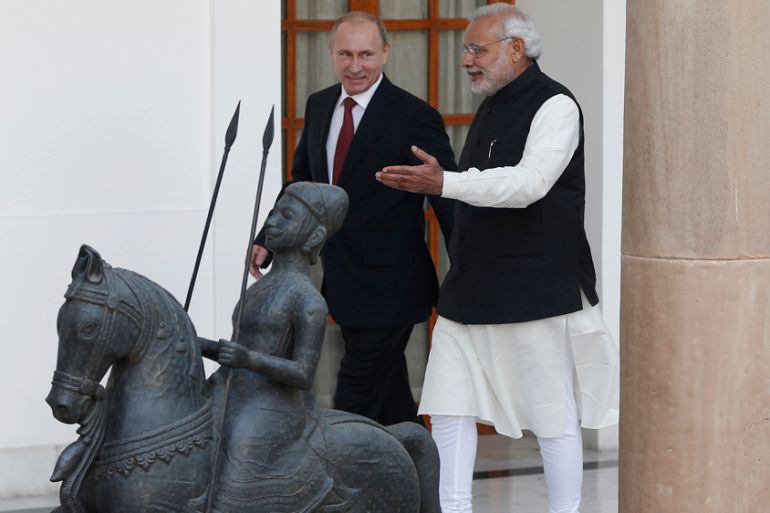Narendra Modi’s international balancing act
In India, the Modi administration is courting world leaders in a bid to boost the country’s clout – and bottom line.

New Delhi, India – India has recently become a “rich fiancé with many bridegrooms” in the words of Alexander Kadakin, the Russian ambassador in New Delhi.
In the eight months since Narendra Modi took office as India’s prime minister, the country has hosted Chinese President Xi Jinping, Russian President Vladimir Putin, and US President Barack Obama – giving some the impression that all the big powers are seeking India’s hand.
Keep reading
list of 4 itemsWhy are nations racing to buy weapons?
Parallel economy: How Russia is defying the West’s boycott
US House approves aid package worth billions for Ukraine, Israel
Modi’s visits to Japan, Australia, and the US were filled with hype, humour and hyperactivity. The prime minister rarely missed a chance to emphasise his personal connections with world leaders and his fierce ambition to make India a global player.
So far, the strategy seems to be paying off – for instance, the Indian leader has already convinced the US and other powers to support India’s bid for a permanent seat on the United Nations Security Council.
Beyond Pakistan
“We have to get over our Pakistan obsession – which is a very north Indian thing – and look out to play our role as a firm and responsible power on the world stage,” said Kiren Rijuju, India’s minister of state for home affairs, in January.
![Indian Prime Minister Narendra Modi addresses an election campaign rally [AP]](/wp-content/uploads/2015/02/4a7649b5901a47a88cc09015d628fdd0_18.jpeg)
Rijuju’s words sum up what his boss, Prime Minister Modi, is looking to achieve. “You cannot ignore the problems Pakistan poses for India,” said Binoda Mishra of the Calcutta-based Centre for Studies in International Relations and Development. “But if we just get stuck handling those, we will never realise our full potential as a global player.”
Modi’s aggressive courting of world powers has left many puzzled – especially the Chinese. Obama and Modi’s announcement of a “Joint Strategic Vision for the Asia-Pacific and Indian Ocean Region” on January 25 upset China because it detailed plans for intelligence-sharing, maritime surveillance, and the “rule of law on the seas” – using not-so-oblique references to disputes over the South China Sea involving Beijing.
China quickly thereafter warned “external countries” to stay away from these disputes, and expressed its uneasiness at the Indo-US nuclear and defence deals.
Meanwhile, Modi’s Foreign Minister Sushma Swaraj was closeted in discussions with Chinese President Xi Jinping, who broke protocol by receiving an official at the ministerial level, and not a head of state. At the end of the discussions, Xi surprised many by saying: “I have full confidence in the future of China-India relations, and I believe that real progress will be achieved in growing this bilateral relationship in this new year.”
Courting all players
While Modi was working on bringing India closer to the US, his foreign minister seemed to have set the stage for a potential breakthrough in resolving the long-standing dispute between China and India over its shared border – a conflict that led to a brief war in 1962.
Swaraj finalised the date of Modi’s China visit for May, during which she expected a “framework agreement” to resolve the disputed 4,057km-long Himalayan border.
“After the breakthrough on the Indo-US nuclear deal, this border pact with China is the next big diplomatic target set by the Modi administration,” said a senior Indian foreign service official accompanying Swaraj, who was not willing to be named.
Swaraj’s Beijing trip also coincided with China joining Russia in promising support for an Indian-sponsored UN resolution on terrorism that may leave arch-rival Pakistan fuming.
And in his new Foreign Secretary S Jaishankar, Modi has a top diplomat who has played vital roles both in handling the nuclear deal with the US – which ended its ban on nuclear trade with India – and the border negotiations with China, during his tenure as envoy in both countries.
“Jaishankar is one who can implement Modi’s multi-alignment policy, his grand vision of doing business with all,” said analyst Sujit Chakrabarty.
The Modi administration is courting all players. Less than a week after Obama referred to Russia as a “bully” in New Delhi with Modi by his side, Swaraj was committing India to “deepening coordination and consultation on the Asia-Pacific region” with China and Russia, and “firmly opposing” western sanctions against Russia.
So Modi is swimming with the crocodile and hunting with the hounds.
‘Multi-alignment’
Some analysts say Modi is putting an end to India’s traditional non-aligned stance, by adopting a policy of “multi-alignment” instead.
Diplomacy for development and growth is his underlying objective. You need business with all to be in business.
“India seems set to become multi-aligned, but always charting its own independent course,” explained Brahma Chellaney of the Delhi-based Centre for Policy Research.
“It had rebuffed US pressure to join American-led financial sanctions against Russia, and has publicly emphasised the need to defuse Cold War-type tensions. A multi-aligned India … will be better positioned to expand its strategic influence.”
This approach, observers say, will help to boost India’s clout on the global stage. “India is not a major power, but it is … capable of swinging the global balance of power,” wrote Indian-American analyst Parag Khanna in his acclaimed book The Second World.
Similarly, Sabyasachi Basu Ray Chaudhury, who teaches international politics at Rabindra Bharati University in Calcutta, told Al Jazeera: “[India’s] markets, its skilled manpower, its location in Asia, its intellectual tradition, and its success with democracy in a poor and diverse country makes India a country none can ignore any more.”
Modi’s foreign policy overdrive has an economic dimension as well: namely, to sell India as a destination for global capital.
“Diplomacy for development and growth is his underlying objective,” said Nakib Ahmed of the Indian Chamber of Commerce. “You need business with all to be in business.”